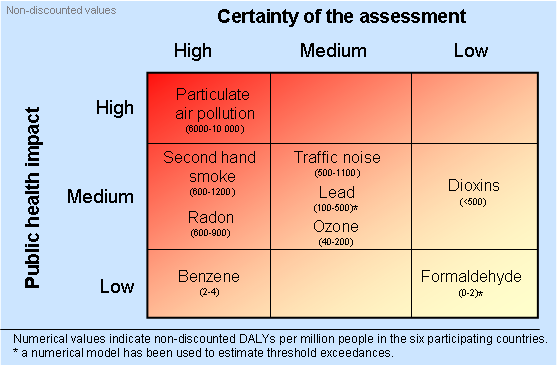EBoDE
| This page is a product of the EBoDE project. The final report of the EBoDE project has been published as a report in 2011[1] and also as web pages in Opasnet. These links lead to parts of the report.
EBoDE project: main page | overview | contributors | data overview | Parma meeting | abbreviations | all pages Methods: environmental burden of disease calculation | selection of exposures and health effects | data needed | impact calculation tool Health effects in Europe: benzene | dioxins | formaldehyde | lead | ozone | particulate matter | radon | second-hand smoke | transport noise | environmental burden of disease | results by country |
Ranking of environmental stressors by health impact in Europe (EBoDE pilot)
Ambient air pollution and environmental noise are the leading causes of the environmental burden of disease in selected European countries, followed by indoor radon, passive smoking, lead, and ozone exposures. These are results of the multinational Environmental Burden of Disease in Europe (EBoDE) project in six participating countries¹.
The calculations were based on the most recent scientific evidence concerning population exposure and health effects. WHO environmental burden of disease methodology² was used to quantify disability adjusted life years (DALY) lost due to environmental stressors. In this first phase of the project preliminary calculations were carried out for nine environmental stressors having sufficient evidence linked to health outcomes (first priority stressors, see figure).
The pilot study covered a broad range of exposures considered significant for public health, individual risk, societal concern, or economy. Besides methodological improvements, the next steps include better coverage of stressors, end-points, countries, and the evaluation of the effectiveness of alternative risk mitigation policies. The estimated environmental burdens of disease form an essential background for efficient policy development.

¹ Participating countries and institutes: VITO, Belgium, THL, Finland, InVS, France, UBA, LIGA.NRW, and University of Bielefeld, Germany, University Milan and ISS, Italy, and RIVM, the Netherlands.
² WHO Quantifying environmental health impacts: http://www.who.int/quantifying_ehimpacts/en/
References
- Hänninen O, Knol A (eds.), Jantunen M, Kollanus V, Leino O, Happonen E, Lim T-A, Conrad A, Rappolder M, Carrer P, Fanetti A-C, Kim R, Prüss-Üstün A, Buekers J, Torfs R, Iavarone I, Comba P, Classen T, Hornberg C, Mekel O, 2011. European perspectives on Environmental Burden of Disease: Estimates for nine stressors in six countries. THL Reports 1/2011, Helsinki, Finland. 86 pp + 2 appendixes. ISBN 978-952-245-413-3. [3]
- Lindsey Konkel: Shared Burden: Public Health Impact of Nine Environmental Pollutants in Europe. Environ Health Perspect; doi:10.1289/ehp.122-A136 [4]
- Otto Hänninen, Anne B. Knol, Matti Jantunen, Tek-Ang Lim, André Conrad, Marianne Rappolder, Paolo Carrer, Anna-Clara Fanetti, Rokho Kim, Jurgen Buekers, Rudi Torfs, Ivano Iavarone, Thomas Classen, Claudia Hornberg, Odile C.L. Mekel, and the EBoDE Working Group. Environmental Burden of Disease in Europe: Assessing Nine Risk Factors in Six Countries. Environ Health Perspect; doi:10.1289/ehp.1206154 [5]
- First meeting report - WHO, Bonn, 12–13 February 2009 (pdf, 94KB)